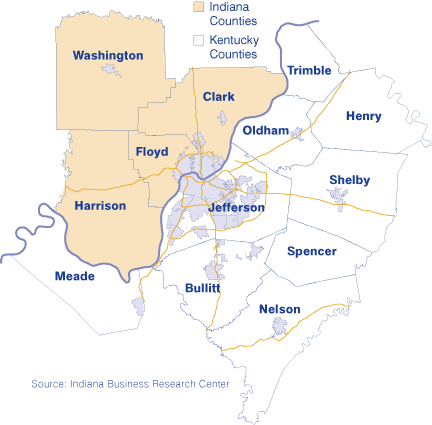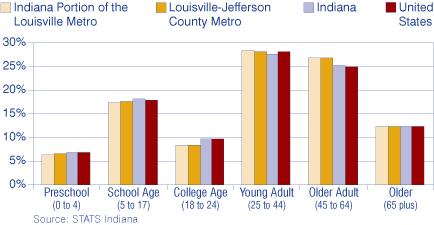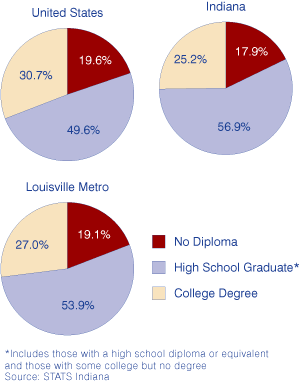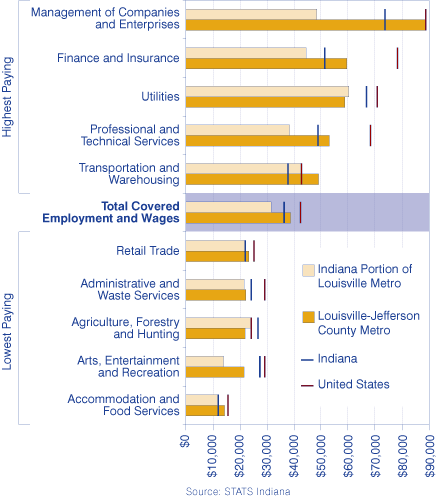The Louisville Metro Story: Told by STATS Indiana
This article, the second in a series of 16 about Indiana's metro areas, will focus on the Louisville–Jefferson County metro. This metro spans counties in Indiana and Kentucky, so this article will include data on the full metro, as well as the Indiana portion of the metro for comparison purposes. All data used for this article are available via the USA Counties and Metros Side-by-Side feature on STATS Indiana (www.stats.indiana.edu).
The Area
The 13 counties that make up the Louisville–Jefferson County metro had a population of 1.2 million in 2006. The city of Louisville is in Kentucky, but four Indiana counties are included in the metro (see Figure 1). These four counties comprised about one-fifth of the metro population, but more than one-third of the land area in the Louisville–Jefferson County metro. Since 1990, the Indiana portion of the metro has grown faster (17.2 percent growth in population) than the Louisville metro (15.7 percent) and Indiana overall (13.9 percent). However, this still lags the nation's 20.3 percent growth over that same time.
Figure 1: The Louisville Metro

The breakdown of the metro's population by age shows mixed results for the area. On the upside, the area has a higher proportion of residents in a prime working-age cohort (age 25 to 44) than Indiana and the United States. However, Figure 2 shows that the area (both as an entire metro and the Indiana portion) has smaller proportions in the three age groups for those less than 25 years old. This indicates that in-migration of people of working age in the years to come will be necessary to maintain those proportions.
Figure 2: Percent of Population by Age, 2006

Jobs & Wages
For the past 10 years (1996 to 2006), the Indiana portion of the Louisville metro has remained relatively stable as a percent of the metro's total jobs, maintaining between 15 and 15.9 percent of jobs in the area. Manufacturing is the top industry in the Indiana counties of the Louisville metro, the Louisville metro overall, and the state of Indiana. However, this industry comes in third at the national level, behind health care and social assistance and retail trade. Not surprisingly, manufacturing is most prevalent in Indiana (19.6 percent of all covered employment). Even the four counties of the Louisville metro within Indiana's boundaries are heavily weighted toward manufacturing (19 percent) compared to the metro overall, which had 13.2 percent of jobs in the manufacturing industry in 2006.
The accommodations and food services sector is one of the top three industries in Indiana's four Louisville metro counties (along with manufacturing and retail trade). This differs from the norm, where manufacturing, retail trade and health care and social assistance take any one of the top three spots. This could be part of the reason average annual wages are lower in the four Indiana metro counties ($31,578), since accommodation and food services is the lowest paying industry in the area (see Figure 3).
Figure 3: Five Highest Paying and Five Lowest Paying Industries in the Louisville Metro, 2006
As a percent of the U.S. total, average annual wages in the Louisville metro held up fairly well. In 2006, the metro paid an average wage of $38,673, or 90.9 percent of the average U.S. wage paid across all industries. This is better than Indiana overall, which paid 85.9 percent of the U.S. average wage, and the Indiana portion of the Louisville metro, which paid only 74.2 percent of the U.S. average.
Education
With the increasing importance of a highly skilled workforce, let's look at the educational attainment levels of residents in the Louisville metro compared to Indiana and the nation. In the metro, 27 percent of the population 25 and older had an associate's degree or higher. Compare this to 25.2 percent for Indiana and 30.7 percent for the United States in 2000. Indiana may be doing best though when looking at the overall picture. Only 17.9 percent of the adult population age 25 or older in Indiana did not graduate high school (see Figure 4).
Figure 4: Education in the United States, Indiana and the Louisville Metro, 2000

Conclusion
The four Indiana counties of the Louisville metro play an important role in the metro economy. We find evidence of this both by the increasing population and by looking at the commuting data, which show that 52.8 percent of workers living in the Indiana portion of the metro commute, compared to 27.8 percent of workers living in the metro overall. What does this mean? While the Indiana portion of the Louisville metro may appear to be struggling in terms of its industrial composition, the overall picture shows that an increasing number of people are choosing to live in Indiana while working in Louisville, benefiting the overall metro economy.
Molly Manns, Associate Editor
Indiana Business Research Center, Kelley School of Business, Indiana University

